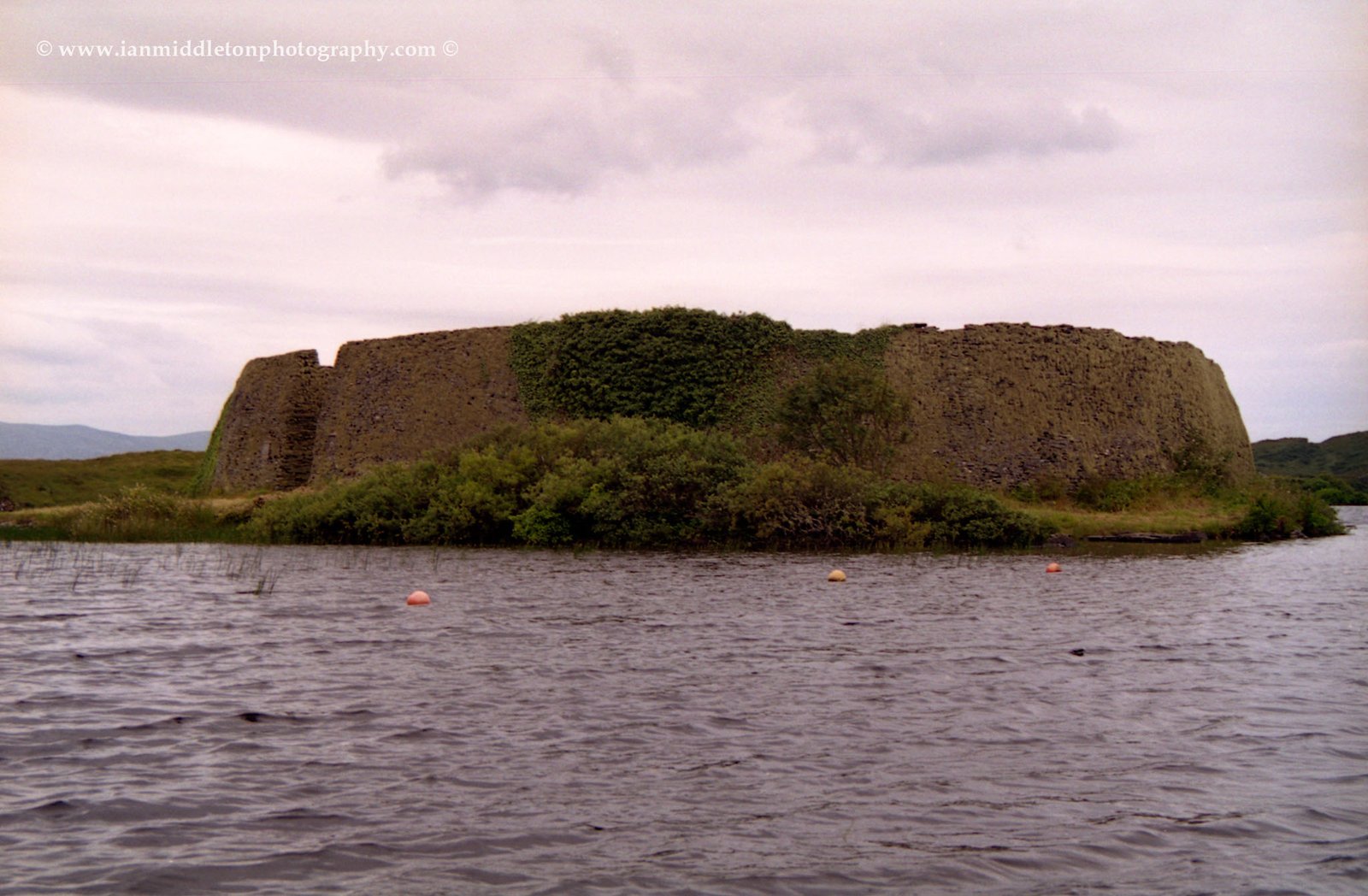The Wild Atlantic Way Part 3
Southern Donegal
A series of articles about locations along this 2500km marked tourist route, which runs from Derry in the north to Kinsale in the south
While vastly different to the North, Southern Donegal is stunning in many ways. Visit the mysterious Doon Fort, Kilclooney Dolmen, fascinating Glencolmcille & the amazing Slieve League sea cliffs.
The Bluestack MOuntains
Heading southwards on the N56 the landscape changes from stark to lush green as you enter the Bluestack Mountains. The Bluestacks are in start contrast to the Derryveagh mountains to the north, and they form a border between northern and southern Donegal. I once hiked over these mountains on my 280-mile hike walk for asthma from Wexford to Donegal. Just like the north, there are plenty of fascinating places to visit, starting with the magical and mysterious Doon Fort.
Doon Fort
Enshrouded in mystery, this ancient stone fort lies camouflaged on a lake island near Kilclooney and Portnoo. Heading south on the N56 take the R261 at Maas and head for Portnoo. Nearby is the Lake Loughdoon. Near to the lake look out for a sign for boat hire. If you can’t find it just ask around. At the time when I visited many years ago I followed lane to a white house and knocked there. The owner pointed me to a small blue rowing boat. Take the boat and row out into the lake, where the mystery will be revealed.
“It keeps its secret until the very end,” I’d been told by a guy in Ardara. And he was right. The lake had been barely visible the whole time I looking for it until I got much closer. And as I rowed out along the edge of the cliff that sheltered the harbour, I still couldn’t see any fort. The water was still, and the splash and subsequent rush of water as I rowed out into the lake was deafening in the surrounding silence. Suddenly, as I cleared the shelter of the hill and the currents became stronger, it appeared like a ghost on the horizon.
This drystone ring fort stands 16 feet high and completely covers a small island just off the shore. Moss covering the walls camouflages the fort and helps keep it hidden until the very last moment. I struggled to negotiate my way through the rocks and dock at the makeshift pier by the fort, pulling the boat well up onto the rocks for fear of losing it.
At 13 feet, the walls of the fort are almost as thick as they are tall. At the entrance are a number of passages inside the walls, one leading out to the top. This was a fortress of the O’Boyles, and Connor O’Boyle was slain here in 1530. It’s unusual to find a fort hidden away here in the middle of the lake.
Kilclooney Dolmen
A little further south of Loughdoon on the R261 is the little village of Kilclooney. A dolmen lies in a field behind the house next to the big modern church. This is private land, knock on the house door and ask the landowner for permission to visit the dolmen.
Kilclooney Dolmen stands 6 feet tall and has a 20-foot capstone that, from certain angles, gives the appearance of a giant albatross in flight. From the rear it gave the less poetic appearance of a stealth bomber. Apparently if you kiss the capstone and make a wish, it will come true. Personally, I wasn’t about to find out.
Slieve LEague Peninsula
While Southern Donegal is abundant with stunning places to visit, one of the best areas to visit lies on the Slieve League Peninsula just south of Ardara. Just past Ardara, branch off on the R230. This road takes you on a breathtaking journey over undulating hills and down into lush, often misty valleys, that look like they have been neatly sliced with a sharp knife. The road snakes through this stunning landscape until finally you cross the brow of a hill to reveal an incredible vista of green hills and a golden beach nestled between two cliffs. Sitting serenely at the edge of this beautiful view is the little village of Glencolmcille.
Saint Columba
The name Glencolmcille, or “Gleann Cholm Cille” in the Irish language, literally means “The Glen of St. Colmcille’s Church”. The area got its name after being visited by the famous Saint Colmcille in the 6th century.
St Colmcille was born in County Donegal. He is said to have banished the demons that fled here after being ousted by Saint Patrick from nearby Croagh Patrick. Colmcille drove them out into the sea, where he ordered them to live as red fish with one eye, so no fisherman would inadvertently capture and eat them.
Glencolmcille
Glencolmcille is littered with ancient history. There are approximately 80 documented Pagan and Christian sites on this peninsula spanning 5000 years. Long before he came here the Neolithic people left their indelible mark upon the land. The peninsula is littered with dolmens and standing stones.
Many of the standing stones were Christianised by Colmcille who, rather than invoke the wrath of the people by destroying them, engraved Christian emblems upon them and encouraged the people to make a pilgrimage there to atone for their sins. These stones now make the 3½ mile Turas which is taken on the saint’s feast day, 9th June, or the Sunday preceding it. After 1500 years this is still carried out. It starts at the modern church of Ireland and is easy for anyone to follow as it’s marked by a number of stations.
- Donegal Coast One Day Self-Guided E-Bike Tour

- Price: $55.84
- 8-Day Donegal Guided Walk

- Price: $1840.97
Irish music and language
Glencolmcille is a popular haunt for musicians, artists and students of the Irish language. There is a school down in the village where Irish courses are given. And the pubs in town have regular live music. My favourite is Teach Biddy on the corner as you enter town. It’s the oldest pub in Glencolmcille and a cosy little place where you sit next to the musicians as they play.
There are many great places to stay here, but without doubt the best is not a 5 star hotel, but a great little backpacker’s hostel perched upon a cliff edge overlooking the beach and surrounding mountains: the Dooey Hostel.
Aside from its colourful owners, its greatest feature is the common room with big bay windows affording a stunning view across the valley. For that reason alone I would give it 5 stars.

It may be hard to believe, but County Donegal has some of the most beautiful and pristine sandy beaches in Ireland. The one at Glencolmcille is no exception, and being flanked by high cliffs makes it even more stunning. While the weather may not always make it the perfect place for swimming and sunbathing, it’s a perfect place to walk, take in the sea air, and start a hike up over the surrounding cliffs.
Slieve League
A more famous beach is Silver Strand, situated to the south at Malin Beg. It’s also a great starting point for a hike to Slieve League, the 7th highest sea cliffs in Europe.
If hiking to the cliffs seems a little too strenuous, then you can also drive most of the way. At the village of Carrick turn off for Teelin. In Teelin you can stop at the Slieve League Cliffs Centre, which is packed with local history and culture. To view the cliffs you can drive up to a small car park, that leads to the Bunglas viewing point. If you feel like a little walking, then park at the first car park lower down and you can walk to the viewing point. You can also book a guided walk.
The more fearless among you might want to hike to the highest point of the cliffs. For this you must take a narrow pathway from the viewing point to One Man’s Pass.
From wherever you stand, the panorama before you will not disappoint. The highest point is 300 metres. From the viewing point the cliffs, being pounded by the wild Atlantic Ocean, seem impenetrable, but amazingly remains have been found on their sheer slopes of an early Christian monastic site, with a chapel and stone beehive huts, much like the ones on Skellig Michael. Ancient stone remains also lay claim to the likelihood of early pagan pilgrimages.
Viewing these cliffs at anytime is amazing, but without doubt the best time to be here is at sunset. Just make sure you get back down safely.
Getting to Ireland
Dublin is the main airport for the Rep of Ireland, or else Belfast in Northern Ireland. If you are coming from within Europe then the following airlines are worth looking at.
Wizz Air: Personally I have always found them to be the best and offer the lowest fares.
Skyscanner: A great place to search and compare flights
Ebookers: Ebookers have been around for longer than most and have always offered a great choice of flights.
Getting around
CAR
The best way to get around Ireland is by car. Either take your own car or you can rent one easily from Dublin or any other major city. Here are three great places to look:
BUS
The national bus service connects most major cities, towns and villages and is a good way to get around, especially if you want to meet some locals
If you want a fun way to travel with other like-minded travellers then try the Paddywagon
TRAIN
The national train service also serves a lot of the larger towns and cities. Great for getting from one side of the country to the other.
Tours:
Roc Tours Ireland – Great private driver tours all over Ireland. (Highly Recommended)
Accommodation
Holidu: This is a great website to search for a variety of places to stay.
Hostelworld: If you are looking for budget accommodation then Hostelworld is a great place to search for a variety of backpacker hostels, B&Bs and hotels.
Wild Atlantic Way Part 1
Wild Atlantic Way Part 2
My Ireland Book
Read the story of my first ever trip around Ireland in my book, Hot Footing Around the Emerald Isle.
With just a backpack as a home, a guidebook in one hand, a bizarre travelogue in the other and very little money in my bank account, I leave my home and set off to this little country that has always been my neighbour, yet overlooked by myself for many years as I pursued dreams to travel to far and exotic countries. However, I was soon to learn that one of the most beautiful places in the world was right on my doorstep.






















3 responses